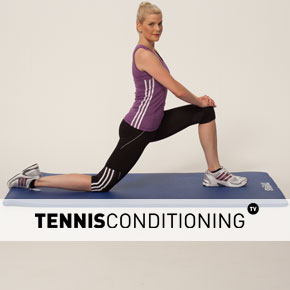Why is flexibility so important for tennis players? For one it can limit your ability to develop power!
In last week’s episode I explained the benefits of a proper warm up routine.
Today I will explain how flexibility impacts on-court performance because, often times, flexibility is an underemphasized training component by many coaches.
Therefore it is one of the prominent performance limiting factors because poor flexibility not only negatively impacts kinetic chain efficiency but also can lead to severe knee or back pain.
Find out how to prevent knee pain and improve knee strength.
Therefore you should make sure to correct muscular imbalances and attain good overall flexibility. We have a great workout for you to correct upper body strength imbalances!
Talking Points
- Flexibility as a performance limiting factor
- Benefits of good flexibility
- How flexibility impacts performance
- Sample dynamic & static stretching routine
Flexibility As A Performance Limiting Factor
The most underrated – and underemphasized component of most training programs is flexibility. The reason for this is that the tangible outcomes are tough to quantify.
For instance, when you commit to flexibility training, is there a direct gain in size or speed?
No, but flexibility affects all the training components such as speed and power indirectly because flexibility is one of the factors limiting your ability to develop power…but how?
For example, stride length impacts running and jumping economy (how efficiently one moves on the court), thereby affecting the amount of energy needed to move on the court or jump for a serve.
Therefore, flexibility does affect speed and power, but indirectly.
Correcting Muscular Imbalance
Many tennis players have muscular imbalances, especially at the shoulder joint where the force producing shoulder (right shoulder for right-handers) is more muscular but less flexible than the less dominant shoulder.
This becomes evident when taking a closer look at the shoulder blades (scapulae), which are “uneven”, causing postural imbalance.
Also, muscular imbalance of the trunk and hip musculature can cause severe problems because, for instance, you can have tightness on one side due to agitation (contracture).
That can causes ¼ inch limb length discrepancy.
That matters with respects to the kinetic chain (transfer of energy), where unevenness can lead to back pain or knee pain.
Chapter 4 of Advanced Concepts of Strength & Conditioning for Tennis, called Fitness Assessment, provides you with a wide variety of tests that help you to determine deficiencies and the following chapters provide exercises to correct the deficiencies.
Benefits of Good Flexibility
Now what are the benefits of good flexibility? Here they are:
- reduces tension
- produces muscle relaxation
- aids in recovery
- improves joint health
More specifically, myofascial deformation occurs when the fascia’s tension capabilities are corrupted. When that happens the fascia doesn’t have the elastic properties and the tissue shortens.
When you regularly use appropriate stretching exercises in the training program, your muscles will become more pliable and you will not experience shortening of the muscle in certain areas.
Since muscles (tendons) connect bones with each other, poor flexibility causes problems.
If the muscles are short, the bones will consequently be closer together but if the bones are closer together movement at the joint will be limited (e.g. feet will turn inward during squats.
The foot position will be influenced due to instability and/or muscle tightness [e.g. in abductors pulling on femur]).
Flexibility is also a component of recovery. If you static stretch well after a long match or tough practice, muscle soreness will be reduced to a large extent and this will allow you to play/practice the next day instead of resting.
In addition to the aforementioned, flexibility also plays an important role in overall joint health because it influences the integrity of the joints.
How Flexibility Impacts Performance
As I mentioned in episode 12, warming up and stretching the muscle tissue reduces the risk of injury and increases performance potential.
Subsequently, good flexibility positively affects movement range (ROM; range of motion) of the respective joints as well as overall dynamic energy transfer efficiency.
The movement range of the joints impacts your speed developing capabilities because flexibility can limit your ability to lengthen your stride.
Most athletes’ stride length is compromised by loss of dynamic stability due to locomotion (the loss and regain of stability).
The goal is to maintain dynamic equilibrium, which can only be accomplished when the center of gravity remains within the base of support.
Therefore, if stride length shortens, the base of support will decrease. That makes it more difficult to maintain the center of mass over the base of support.
Thus making it more difficult to maintain dynamic stability.
Stride length is affected, amongst other things, by the flexibility of the hamstrings. When you have tightness in the hamstrings, the legs cannot extend out all the way.
That decreases the distance you cover with each step and this will limit overall speed.
Also, if you experience tightness or imbalance in the gluteals (buttocks) and hip flexors, you can’t change the pelvic position as it relates to the spine and you will experience dynamic instability and inefficiency in energy transfer.
Training Zone
We provide you with some stretches and workouts you may be interested in to optimize your training.
Also, make sure that you warm up properly before and stretch out after your training session.



